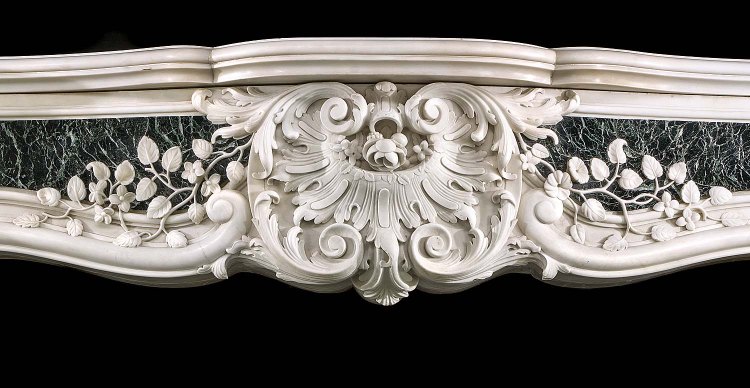10 May 2017

We are thrilled to introduce a magnificent chimneypiece into our collection. Dating to 1750, carved in white statuary marble and inlaid with panels of the finest Verdi Antico[i], this piece epitomises the English Rococo[ii] style of the eighteenth-century. The eighteenth-century is often viewed as the age of opulence for European design. Following the flamboyant, yet formal Baroque period, the Rococo burst forth, unleashing a sinuous abundance of floral and foliate motifs, reinventing the classical ideals in architecture, art and design. This fireplace does just that.

In the centre of the panelled frieze beneath the undulating serpentine shelf, is an elaborate pelta[iii] scroll cartouche, from which emanates an abundance of deftly carved acanthus and convolvulus. The generous C-scrolls of the endblocks are supported by the canted console jambs, which terminate in single fronds of the hart’s tongue fern.

The combination of exquisite quality and provenance united in this chimneypiece makes this a very significant addition to our inventory. The first known record of the chimneypiece dates to 1891, when it was installed in the Octagonal drawing room of Minto House in Roxburghshire by the Mayfair decorators W. Turner Lord & Co. The foliate decorations on the fireplace, echoed the magnificent ceiling cornice, modelled on the 18th century French style.

Before its installation, Minto House had undergone a Palladian transformation by the foremost Scottish architect of the eighteenth-century: William Adam. The Forefather of the “Adam Style” which swept through the country estates of Great Britain, Adam’s plans were grand in scale, enveloping the original 16th century tower house. The property was further developed by the illustrious Archibald Elliot between 1809-1814 under the instruction of the 1st Earl of Minto – then Governor General of India. The Earl died on route to Scotland from India, and never saw the work completed. The house however continued to attract a number of well-known architects and decorators.

On inheriting Minto, the Fourth Earl was entirely unaware of the dire financial situation which had befallen the estate. The house was in urgent need of repair, and an outbreak of typhoid caused by its outdated sanitation impelled the new Earl to completely renovate the property; using W. Turner Lord and Co as decorators. They submitted an estimate of £1,342 for the renovations of Minto in 1891. The final bill was £3,926, a huge blow for the estate. It was during this ambitious renovation that the chimneypiece was installed, after which it remained in situ even as the property descended into disrepair. After years of neglect, the house was finally demolished in 1992. This exquisite chimneypiece still remains: a noble vestige of Scotland’s finest houses and its former glory.

DETAILS HERE
[i] Verde Antico was known as Lapis Atracius to the Romans and was quarried in Larissa, Greece.
[ii] The Rococo style takes its name from a popular French term of the 18th century, the Rocaille et Coquille, meaning rock and shell – referring to the use of these motifs in Rococo design.
[iii] Pelta derives from the Ancient Greek, péltē, meaning shield.